A team of scientists from the US Westlake University and China’s Zhejiang University have developed High Tech Janus fabric, consisting of several layers and using the unique properties of polytetrafluoroethylene eRTFE (Teflon). Janus also contains special components that provide the fabric with the ability to keep the wearer warm in winter and cool in summer.
The double-sided textile not only reflects heat in the summer and retains heat in the cold season, but is also capable of generating a small amount of electricity, enough to keep wearable mobile devices running.
Janus fabric has two orientations. In the “winter” version, the outer layer of textile, which contains nanoparticles of zinc and copper, absorbs solar energy and blocks the outflow of heat, warming the user. When you turn the garment inside out, the second, “summer” layer of Janus fabric, covered with PMMA polymer, will reflect sunlight and remove excess heat.
Janus testing was carried out on artificial human skin samples covered with the fabric in both modes of operation. When testing the “winter” side of textiles, the scientists recorded heating of the artificial skin by 10 degrees Celsius, compared to using black cotton fabric. In contrast, the “summer” version of the fabric reduced the temperature of the skin by 11.6 degrees Celsius, compared to using a white cotton fabric.
It is noteworthy that the Janus fabric production technology does not require large expenditures and sophisticated high-tech equipment. An additional bonus when using the new fabric is the generation of electricity using a thermogenerator that operates from the temperature difference between the outer and inner layers. The amount of electricity produced by Janus garments is sufficient to power mobile electronics.







